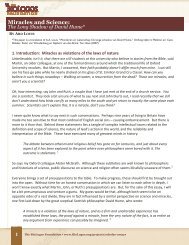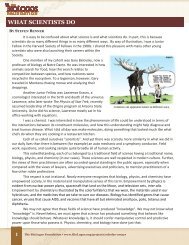The Biblical Creation in its Ancient Near Eastern Context - BioLogos
The Biblical Creation in its Ancient Near Eastern Context - BioLogos
The Biblical Creation in its Ancient Near Eastern Context - BioLogos
Create successful ePaper yourself
Turn your PDF publications into a flip-book with our unique Google optimized e-Paper software.
<strong>The</strong> <strong>BioLogos</strong> Foundation • www.<strong>BioLogos</strong>.org/projects/scholar-essays<br />
to creation. In Genesis 1, the creation is not the prelude to the build<strong>in</strong>g of a temple. Rather, the creation<br />
<strong>its</strong>elf, <strong>in</strong> <strong>its</strong> entirety, is God’s temple; the heavens and the earth are the doma<strong>in</strong> of God’s sovereign rule. In<br />
fact, this concept is particularly clear <strong>in</strong> another famous verse from the book of Isaiah (Isaiah 66:1):<br />
“Heaven is my throne, and the earth is my footstool; what is the house that you would build for me, and<br />
what is the place of my rest?” So then, Genesis 1 portrays the entirety of creation as God's temple, the<br />
realm of his rulership. This idea is re<strong>in</strong>forced <strong>in</strong> the culm<strong>in</strong>ation of the story on the seventh day, <strong>in</strong> which<br />
God “rests” from his work – aga<strong>in</strong>, a po<strong>in</strong>t which makes sense along the l<strong>in</strong>es of creation as the abode out<br />
of which his rulership emanates.<br />
What then, about part two of this po<strong>in</strong>t, the place of human be<strong>in</strong>gs <strong>in</strong> the creation? Day 6 <strong>in</strong><br />
particular speaks directly to the place of humank<strong>in</strong>d <strong>in</strong> creation. Genesis 1:26-27 read thus: “Let us make<br />
man (i.e., humank<strong>in</strong>d – Hebrew ’ādām) <strong>in</strong> our image, after our likeness. And let them have dom<strong>in</strong>ion over<br />
the fish of the sea and over the birds of the heavens and over the livestock and over all the earth and over<br />
every creep<strong>in</strong>g th<strong>in</strong>g that creeps on the earth. So God created man (’ādām) <strong>in</strong> his own image, <strong>in</strong> the image<br />
of God he created him; male and female he created them.”<br />
“In the image of God” – this is yet another place where the <strong>Near</strong> <strong>Eastern</strong> context is essential for<br />
understand<strong>in</strong>g the text. <strong>The</strong> Hebrew word for “image” is ṣelem, which is one of the words <strong>in</strong> the Bible used<br />
to refer to physical images or idols of gods – those idols which were made of gold, silver, some other k<strong>in</strong>d<br />
of metal, or even wood, and used <strong>in</strong> the context of worship. In the ancient <strong>Near</strong> <strong>Eastern</strong> world, every place<br />
had <strong>its</strong> own unique local manifestation of deity, and <strong>in</strong> turn, idols represent<strong>in</strong>g these deities were common.<br />
Modern archaeologists have unearthed a number of these. Moreover, one of the central characteristics of<br />
<strong>Near</strong> <strong>Eastern</strong> temple religion <strong>in</strong> general was someth<strong>in</strong>g called the “care and feed<strong>in</strong>g of the gods.” 7 That is,<br />
the idea of worship was that you wanted to serve the god, to take care of it. We have ample evidence of<br />
this. In Egypt, for <strong>in</strong>stance, as part of a daily ritual <strong>in</strong> some temples, they would clothe the god, feed the<br />
god, wash and bathe it, ano<strong>in</strong>t it with oil, put makeup on it. Very elaborate recurr<strong>in</strong>g rituals were <strong>in</strong>volved<br />
<strong>in</strong> car<strong>in</strong>g for the physical image, the idol, because it was believed to be the true manifestation of the god <strong>in</strong><br />
the midst of the people.<br />
In contrast to <strong>its</strong> neighbors, ancient Israel had a strict ban on the use of images <strong>in</strong> worship. For one<br />
th<strong>in</strong>g, Israel’s affirmation of one god made it unth<strong>in</strong>kable to worship the idol of another deity. But even<br />
when it came to Yahweh, the God of Israel, images were banned. <strong>The</strong> second commandment makes this<br />
clear: “You shall not make for yourself a carved image, or any likeness of anyth<strong>in</strong>g that is <strong>in</strong> heaven above,<br />
or that is <strong>in</strong> the earth beneath, or that is <strong>in</strong> the water under the earth” (Exodus 20:4). <strong>The</strong> idea was that the<br />
essence of the true God could not be reduced to an image made from human hands. It’s notable, then,<br />
that both <strong>in</strong> the Israelite Tabernacle <strong>in</strong> the wilderness and <strong>in</strong> Solomon’s Temple, there was no idol. <strong>The</strong>re<br />
were no images of God. <strong>The</strong>re was only the Ark of the Covenant <strong>in</strong> the Holy of Holies –– that box, with<br />
w<strong>in</strong>ged creatures called cherubim on each side. Based on comparisons with iconography from the ancient<br />
<strong>Near</strong> East, the ark was probably <strong>in</strong>tended to represent God’s footstool, the idea be<strong>in</strong>g that God’s presence<br />
would be above the ark, as if God were seated <strong>in</strong> an <strong>in</strong>visible throne with his feet touch<strong>in</strong>g the footstool.<br />
But <strong>in</strong> keep<strong>in</strong>g with Israel’s understand<strong>in</strong>g about idols, there was no actual image of God <strong>in</strong> the Tabernacle<br />
or the Temple.<br />
When we come back to Genesis 1, then, the po<strong>in</strong>t should be clear, right? In the context of the<br />
heavens and the earth as be<strong>in</strong>g God's temple, human be<strong>in</strong>gs are the image of God. <strong>The</strong> Israelite Tabernacle<br />
and the Solomonic Temple were without hand-crafted images of God, but every time a person walked <strong>in</strong>to<br />
4<br />
<strong>The</strong> <strong>Biblical</strong> <strong>Creation</strong> <strong>in</strong> <strong>its</strong> <strong>Ancient</strong> <strong>Near</strong> <strong>Eastern</strong> <strong>Context</strong><br />
BY JOSEPH LAM




